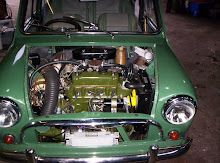If the valves and seatings are in good condition, or have received the appropriate treatment as described above, the next step is to grind-in—or, more correctly, lap-in—each valve on to its seating in order to obtain a gas-tight seal.
Valve-grinding paste is usually supplied in two grades, fine and coarse, in one container. The coarse grade should be used only in an emergency, to remove pitting when proper reconditioning cannot be carried out, but light pitting may be removed with the fine paste until a good matt finish has been obtained.
Each valve should be rotated quickly and lightly with the suction-cup grinding tool, first in one direction and then in the other, spinning the handle of the tool between the palms of the hands as shown in Fig. 25.
From time to time the valve should be raised from its seat and turned a quarter of a turn, grinding being continued from this new position. This will ensure that an even, concentric surface is obtained. Only a light downward pressure on the valve is required. A light coil spring placed
The correct way to hold the suction-cup tool when grinding-in a valve
beneath the head of the valve will make the job easier as it will lift the valve whenever pressure on it is relaxed.
When correctly ground, both the valve seat and the face of the valve should have an even, clean, grey matt finish with no signs of bright rings or any evidence of pitting. Bright rings are caused by grinding with insufficient grinding paste, while "tramlines" are usually the result of continuously grinding the valve on its seat without taking up a different position.
A useful test to check the effectiveness of the seal is to make a series of pencil marks across the seating face of the valve with a soft lead pencil. Replace the valve and rotate it once through a quarter of a turn on its seating. If the valve is seating properly, each pencil mark should be erased at the line of contact. If some of the lines are not broken, the indication is that either the valve or its seating is not truly circular and that renewal or refacing of the .valve or seat (or both) is required.
When all the valves have been ground-in the valves and seatings should be thoroughly cleaned and all traces of grinding paste removed with a piece of clean cloth and a little petrol. Lubricate the valve stems with a little clean engine oil before refitting the valves in their correct positions and reassembling the springs and retainers.
First fit the spring, then the oil shroud, followed by the spring cap. Compress the spring and roll a new rubber oil sealing ring into the groove at the end of the valve stem, so that it rests against the lower edge of the groove. Fit the cotters above the ring and progressively release the spring, making sure that the cotters are seating correctly in the groove and that the rubber ring is not displaced. Relit the spring clip:



0 comments:
Post a Comment